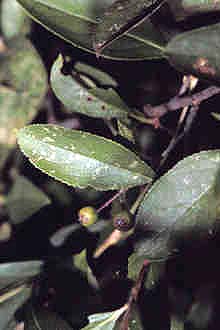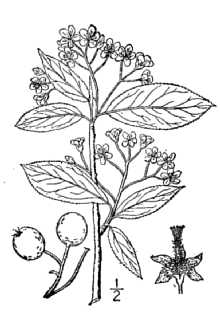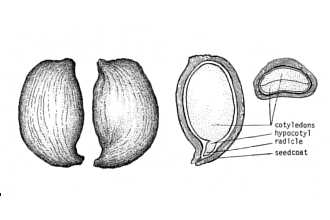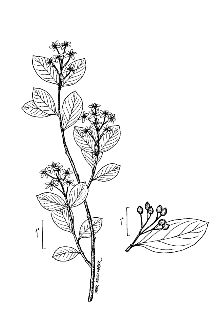Photinia melanocarpa (Michx.) K.R. Robertson & Phipps
Scientific Name: Photinia melanocarpa (Michx.) K.R. Robertson & Phipps

| General Information | |
|---|---|
| Usda Symbol | PHME13 |
| Group | Dicot |
| Life Cycle | Perennial |
| Growth Habits | Shrub |
| Native Locations | PHME13 |
Plant Guide
Alternate Names
Aronia, Pyrus melanocarpa. Photinia melanocarpa.
Uses
Landscaping: Black chokeberry is a deciduous, cold-hardy shrub useful in landscape plantings, showing white flowers in the spring and colorful red foliage and heavy, dark fruit in the fall. Wildlife: Plants are browsed by white-tailed deer and rabbits. The fruit are eaten by ruffed grouse, sharp-tailed grouse and prairie chickens. Economic: Aronia berries can be canned whole or the juice extracted for jelly making, as well as healthful fruit drinks. The juice contains high levels of anthocyanins (source of red color) and flavonoids. The strong, stable natural color is useful in the food industry. This plant is extensively grown in Europe, where yields of up to 38 pounds of fruit per bush have been reported.
Status
Please consult the PLANTS Web site and your State Department of Natural Resources for this plant’s current status (e.g. threatened or endangered species, state noxious status, and wetland indicator values).
Description
General: A member of the Rose family, black chokeberry is a deciduous shrub which can grow to a height of 3 to 6 feet tall, The fine-toothed leaves are medium green and hairless, with raised glands along the top of the midrib, In spring, the white bisexual flowers form clusters that are 2 to 2 ½ inches across, The primary pollinators are small bees, As the seasons progress, the trees turn a deep glossy green, In mid to late summer the fruit begins to form, As the pea-sized fruit ripens, it darkens to a purplish-black color, The fruit are pomes which will begin to drop from the plants shortly after ripening, The fruits are quite juicy, but will begin to shrivel up after ripening, The juice and seeds are deep purple in color, There are 1 to 5 small seeds per pome, Distribution: Black chokeberry is native to the Great Lakes region and the Northeastern U,S,, with a southerly extension into the higher elevations of the Appalachian Mountains, It is hardy to zone 3, For current distribution, please consult the Plant Profile page for this species on the PLANTS Web site, USDA NRCS Plant Materials Center Bismarck, North Dakota Habitat: Moist woods, but also occurs in drier thickets or clearings on bluffs or cliffs, , Use soil moisture sensors to measure the soil moisture of Photinia melanocarpa (Michx.) K.R. Robertson & Phipps.
Adaptation
The black chokeberry grows well in full sunlight, but is moderately tolerant of shade. The best growth and fruit production occurs on low moist but well-drained sites, in full sun. It is not drought-tolerant. New shoots will grow up around established plants, filling in the space between plants like a hedgerow. Some of these shoots are the result of layering.
Establishment
Nursery grown seedlings establish readily if planted free of competing vegetation, in locations having 15 inches or more of annual precipitation. Bareroot seedlings should be planted in the spring, once the threat of frost is over. Containerized stock may be planted from spring to the middle of summer, if there is adequate moisture. The optimum spacing is 4 to 6 feet between plants. If plants are to be used for fruit production, 10-foot spacing gives more room and light to each plant.
Management
Control of invading weeds and grasses is important. Shallow cultivation works best. Cultivation can also be used to stop the spread of shoots and suckers, if that is a concern. Some references report frequent suckering. Very little if any suckering has been noticed on chokeberry in windbreaks in the Northern Plains. Thinning of older stems is recommended every few years.
Pests and Potential Problems
Black chokeberry appears to have very few disease and pest problems. Mildew can become a problem when plants do not receive adequate sunlight and air circulation.
Seeds and Plant Production
Plant Production
Plant Production
Reproduction is primarily by seed. The seeds are small, being slightly more than 1/16 inch long. There are about 276,000 seeds per pound, and about 100 pounds of fruit is needed to produce a pound of seed. Once the fruit is harvested in the fall, it should be cleaned. For small amounts of fruit, a kitchen blender can be used to macerate the fruit. For larger amounts of fruit, a commercial macerator similar to a Dybvig® macerator does a good job of crushing the fruit. Quite a bit of pulp can be removed by floating it off. After the seed and remaining pulp have been thoroughly dried, hand screens or a fanning mill can be used to separate the seed from the remaining dried pulp. Chokeberry seeds have an internal dormancy that can be overcome by being stratified in moist peat for three months between 33°F and 41°F. For nursery scale production of seedlings, it is recommended that the seed be sown in September. The best germination occurs from seed that has been cleaned. Poor germination results from seed that has not been separated from the pulp. Cultivars, Improved, and Selected Materials (and area of origin) At the present time there are no commercial varieties available for conservation plantings.
Conservation
grade stock is available from some conservation nurseries in the upper Midwest. Though black chokeberry is native to eastern North America, it has been planted extensively in Europe and Asia. In Russia, Denmark and eastern Europe the fruit is widely used for juice and wine production. The Europeans have developed several varieties which are now available in the U.S. from commercial nurseries. ‘Viking’ is a vigorous, productive variety from Scandinavia, which can grow to a height of six feet. ‘Nero’ is a shorter growing variety, reaching a height of 3 to 4 feet, with dark blue berries. In the U.S., a selection from a native source in Michigan is being sold as ‘Morton’ black chokeberry. It is marketed in the Midwest under the trademark Iroquois Beauty™. Contact your local Natural Resources Conservation Service (formerly Soil Conservation Service) office for more information. Look in the phone book under ”United States Government.” The Natural Resources Conservation Service will be listed under the subheading “Department of Agriculture.”
Plant Traits
Growth Requirements
| Temperature, Minimum (°F) | 24 |
|---|---|
| Adapted to Coarse Textured Soils | Yes |
| Adapted to Fine Textured Soils | No |
| Adapted to Medium Textured Soils | Yes |
| Anaerobic Tolerance | Medium |
| Cold Stratification Required | No |
| Drought Tolerance | Medium |
| Frost Free Days, Minimum | 88 |
| pH, Maximum | 6.5 |
| pH, Minimum | 4.4 |
| Planting Density per Acre, Maxim | 1280 |
| Planting Density per Acre, Minim | 320 |
| Precipitation, Maximum | 80 |
| Precipitation, Minimum | 24 |
| Root Depth, Minimum (inches) | 24 |
| Shade Tolerance | Tolerant |
Morphology/Physiology
| C:N Ratio | Medium |
|---|---|
| Toxicity | Slight |
| Shape and Orientation | Erect |
| Resprout Ability | No |
| Low Growing Grass | No |
| Nitrogen Fixation | None |
| Bloat | None |
| Coppice Potential | No |
| Fall Conspicuous | Yes |
| Fire Resistant | No |
| Flower Color | White |
| Flower Conspicuous | Yes |
| Foliage Color | Red |
| Foliage Porosity Summer | Moderate |
| Foliage Porosity Winter | Moderate |
| Fruit/Seed Color | Blue |
| Fruit/Seed Conspicuous | No |
| Growth Form | Thicket Forming |
| Height at 20 Years, Maximum (fee | 15 |
| Height, Mature (feet) | 6.0 |
| Known Allelopath | No |
| Leaf Retention | No |
| Lifespan | Short |
| Foliage Texture | Medium |
Reproduction
| Propagated by Seed | No |
|---|---|
| Propagated by Sod | No |
| Propagated by Sprigs | No |
| Propagated by Tubers | No |
| Propagated by Bare Root | No |
| Seed per Pound | 256000 |
| Seed Spread Rate | Moderate |
| Seedling Vigor | Medium |
| Small Grain | No |
| Propagated by Corm | No |
| Propagated by Container | No |
| Propagated by Bulb | No |
| Fruit/Seed Persistence | No |
| Fruit/Seed Period End | Fall |
| Fruit/Seed Period Begin | Summer |
| Bloom Period | Spring |
| Propagated by Cuttings | Yes |
Suitability/Use
| Veneer Product | No |
|---|---|
| Pulpwood Product | No |
| Post Product | No |
| Palatable Human | No |
| Palatable Graze Animal | Medium |
| Palatable Browse Animal | Medium |
| Nursery Stock Product | No |
| Naval Store Product | No |
| Lumber Product | No |
| Fodder Product | No |
| Christmas Tree Product | No |
| Berry/Nut/Seed Product | No |



